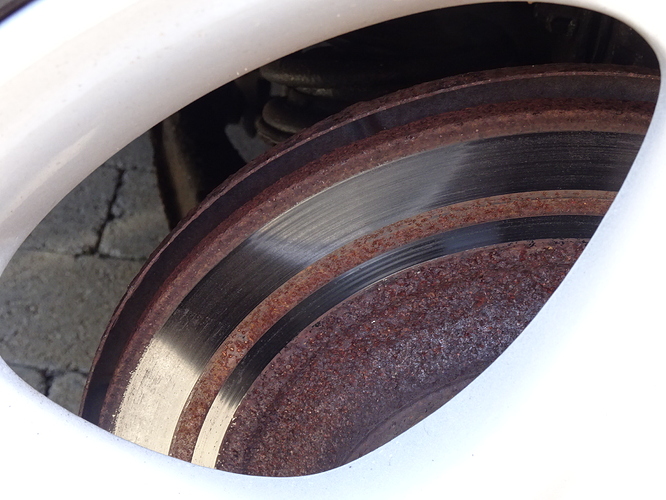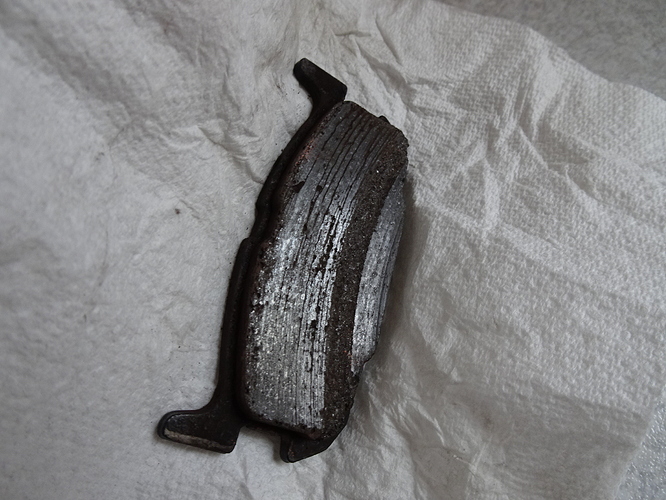The discs on our Mk2.5 always go a little bit rusty if the car sits unmoved for a while but it usually all clears after a short drive, but after the winter lay-up I have noticed that the rear offside brake disc has a band of rust in the middle of it which isn’t clearing, even after some heavy braking.
Does anyone have any suggestions to help sort the problem? I am not particularly mechanical so removal of brake calipers etc. would have to be outsourced to a garage.
That needs some attention. It all depends on how worn the discs are whether you replace them or merely skim them. They’re not that expensive and most people would replace them, and of course also the pads.
I had a similar problem, and posted what I did about it a couple of years ago
1 Like
That’s an unusual pattern of wear, I’d be inclined to replace both discs and pads, both sides of course on the rear.
3 Likes
Thanks everyone. The discs don’t seem to be worn much at all but I will add this to the list for when the car goes in for its annual service (whenever that now ends up being).
The pad has some form of wear.
I’d be tempted to remove the pad and sand it flat, which may help get rid of the rusty area.
Although the correct fix is probably news disks and pads.
1 Like
Thinking about this, it is worth having a look at the hidden back (or inside faces) of the discs, they might be even worse. They might be fine, but you’ll never know without checking.
Out of sight, out of mind, can still bite you… (I’ve cut short the usual rhyme.)
2 Likes
I had this on the rear caliper of my wife’s car. Turned out it needed a new caliper
1 Like
Please never ‘sand’ a brake pad. The grit will stick in the pad surface and cause extremely rapid disk wear.
1 Like
That is weird. Mild rust on the disc mainly cleared. If you remove the pads you would see why this has happened - material completely missing from that part of the pad across the entire width of the pad - very strange.
New pads usually have a more abrasive top layer to allow bedding in to the disc. Assuming that is the only issue I would just fit a new set of pads on both sides.
1 Like
With a dry day in prospect I decided to take a look at this today. With the car jacked and on an axle stand I first cleaned up the disc with some emery paper. It took very little effort at all. The disc looked fine with very little sign of wear.
I then bit the bullet and decided to look at the pads. I have never worked on a car’s brakes before so this was a bit of a step into the unknown. I followed the procedure in the Haynes manual which was fine other than the Lower Guide Pin had to be taken out with a 10mm socket and not an Allen key. Putting it back it said to torque it to 50 Nm but how you are meant to get a torque wrench in I have no idea, so I just did it ‘quite tight’ with a spanner. Hopefully that won’t be a problem.
The front pad was indeed the culprit - it had a noticeable gouge out of it along its length corresponding to the rusty band. No photo I’m afraid as by the time I remembered it was too late. I didn’t have any replacement pads so I just cleaned things up a bit, put some copper grease on the pad backplates where they mount and put it all back together again. Everything seemed to be fine although I noticed the caliper unit seemed to have slightly more in and out movement than before. I’m hoping that is because of the cleaning and greasing and not something more sinister.
We have to go and collect some prescriptions for the neighbours later so I will do a couple of test runs up and down the Close before setting out.
I then need to decide if I replace both sets of back pads myself or get a garage to do it.
1 Like
Glad to hear you got it sorted
The in and out movement is probably just where you have been fiddling and the pistion has not resumed it’s original position. You’ll probably find while driving that the biting point of the brakes will change as it all beds back in. Get some new pads sharpish though, that band will turn into a groove if you leave it too long and you’ll have to replace the discs then too [honestly I would change the discs anyway, I’m finnickety when it comes to brakes and front rotors are not expensive when you take into account the extra piece of mind and the shiny]
1 Like
You will need to change the discs, should be done as a pair. The rusty band will be very abrasive and it will just ruin your new pads. You could get them skimmed perhaps depending on the size of the lip on the edge. Looks like the hubs could do with a coat of paint too.
Never take risks with brakes, buy the best parts you can and keep them 100%
1 Like
Thank you Steeve. I did think about having the disc skimmed. There is no discernible lip at the edge on either side so I’m loathe to swap the discs, but equally I don’t want to trash a new set of pads.
Just to close this off, here is the offending brake pad and as @rhino666 predicted it has a groove in it.
Also, as @RichardFX predicted both the inside pads were only making contact for about 1/2 to 2/3 of their width. Sadly @BrilliantBlackBirdy was also right and both rear calipers were faulty and need replacing, so I will get the discs done at the same time. That saga can be followed here Help needed trying to replace rear brake pads.

